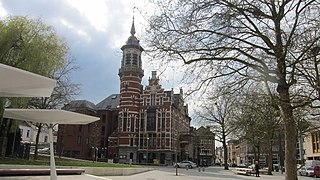
Jette is one of the 19 municipalities of the Brussels-Capital Region, Belgium. Located in the north-western part of the region, it is bordered by the City of Brussels, Ganshoren, Koekelberg, and Molenbeek-Saint-Jean, as well as the Flemish municipalities of Asse and Wemmel. In common with all of Brussels' municipalities, it is legally bilingual (French–Dutch).

Malle is a municipality located in the Campine region of the Belgian province of Antwerp. The municipality comprises the villages of Oostmalle and Westmalle. In 2021, Malle had a total population of 15,620. The total area is 51.99 km2.

Affligem Abbey is a Benedictine abbey in the historic village of Hekelgem, now in the municipality of Affligem, Flemish Brabant, Belgium, 19 km (12 mi) to the north-west of Brussels. Dedicated in 1086, it was the most important monastery in the Duchy of Brabant and therefore often called Primaria Brabantiae.

Averbode Abbey is a Premonstratensian abbey situated in Averbode, in the municipality Scherpenheuvel-Zichem, in the Archdiocese of Mechelen-Brussels in Belgium. It was founded about 1134, suppressed in 1797, and reestablished in 1834. Throughout the 20th century the abbey press was a leading children's publisher in Belgium. The church's building is a peculiar synthesis of Baroque and Gothic, with Renaissance ornament details, dominating the monastery complex. The whole structure was built of iron sandstone from Langdorp and white sandstone from Gobertange between 1664 and 1672, after a design by the Antwerp architect Jan Van den Eynde II.

La Cambre Abbey or Ter Kameren Abbey is a former Cistercian abbey in the City of Brussels, Belgium. It is located in the Maelbeek valley between the Bois de la Cambre/Ter Kamerenbos and the Ixelles Ponds. The abbey church is a Catholic parish of the Archdiocese of Mechelen–Brussels and home to a community of Norbertine canons, while other parts of the monastery house the headquarters of the Belgian National Geographic Institute (NGI) and La Cambre, a prestigious visual arts school.
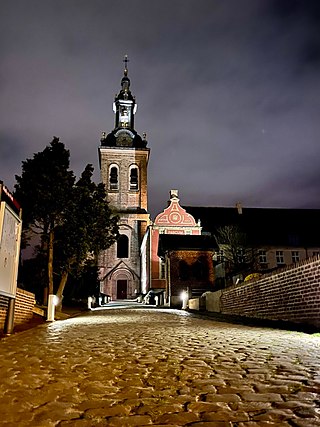
Park Abbey is a Premonstratensian abbey in Belgium, at Heverlee just south of Leuven, in Flemish Brabant.

Keizersberg Abbey, also known as Mont César Abbey is a Benedictine monastery on the hill Keizersberg or Mont César in the north of the university town of Leuven, Belgium.
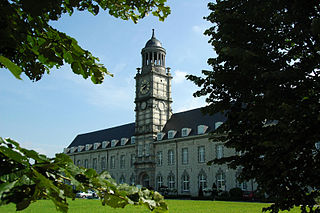
St. Bernard's Abbey, Hemiksem, or abbatiae S. Bernardi ad Scaldim, ordinis Cisterciensis, in dioecesi Antverpiensi also known as St. Bernard's Abbey on the Scheldt, located in Hemiksem in the province of Antwerp in Belgium, was a Cistercian monastery founded in 1243 and dissolved during the French Revolution. The buildings are now the property of the municipality of Hemiksem.
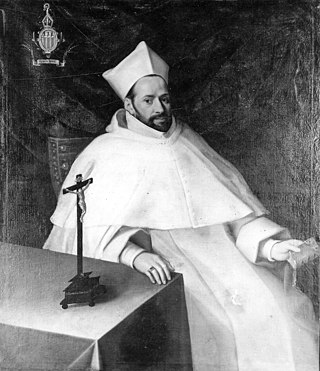
Jan Druys, Latinized Drusius (1568-1634) was a Norbertine canon regular from the Low Countries who became the 30th Abbot of Park Abbey in Heverlee just outside Leuven.

Forest Abbey or Vorst Abbey was a Benedictine abbey located in the Brussels municipality of Forest, Belgium. It was founded in 1105 and existed for nearly 700 years, until its partial destruction by fire in 1764. It was abolished in 1796. Only the abbey's 18th-century outbuildings have been preserved. They are now owned by the municipality and serve as a cultural centre.

Rouge Cloître Abbey or Roodklooster Abbey is a former Augustinian priory, founded in 1367. It is located in the Sonian Forest, in south-eastern Brussels, Belgium. It was abolished in 1796. Nowadays, it is administered by the municipality of Auderghem.

Drongen Abbey, or the Old Abbey, Drongen, is a monastic complex on the River Leie in Drongen, a part of the city of Ghent in East Flanders, Belgium.

Male Castle, Bruges. A community of the Canonesses Regular of the Holy Sepulchre. It originated in Bruges in the 11th century, and between 1954 and 2013 was settled in Male Castle in Male, Sint-Kruis, Bruges, West Flanders, Belgium.

Vlierbeek Abbey is a former Benedictine abbey to the north-east of Leuven in Belgium, in the sub-district Kessel-Lo.

Koningshoeven Abbey is a monastery of the Trappists founded in 1881 in Berkel-Enschot in North Brabant, the Netherlands.

Ninove Abbey was a monastery of the Premonstratensian Order in the center of Ninove, in the province of East Flanders, Belgium. Only the abbey church now remains.

Tongerlo is a village and deelgemeente (sub-municipality) of the municipality of Westerlo in the province of Antwerp, Belgium. The village is located about 10 kilometres (6.2 mi) south-east of the city of Herentals. Tongerlo is best known for Tongerlo Abbey founded in 1128 which became one of the most important abbeys of Belgium.
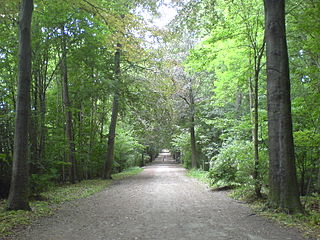
Dieleghem Wood or Dielegem Wood is a public forest in the municipality of Jette in Brussels, Belgium. It covers an area of 9 hectares and was acquired by the municipality in 1952. Along with the Poelbos and Laerbeek Wood, Dieleghem Wood is an integral part of the regional King Baudouin Park.
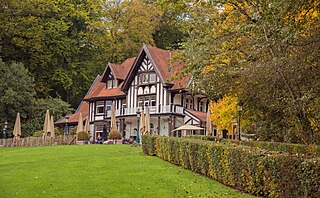
Laerbeek Wood or Laarbeek Wood is a public forest in the municipality of Jette in Brussels, Belgium. It covers an area of 34 hectares, making it the largest forest area in the north of the Brussels-Capital Region. The forest is located on the border with the Flemish Region and is connected to an open space in the north, although the Brussels Ring forms a barrier there. To the south and south-east, Laerbeek Wood borders other green areas: the Poelbos, King Baudouin Park and the Jette-Ganshoren Marshes. To the east, the forest borders the Campus Jette with the UZ Brussel.





















